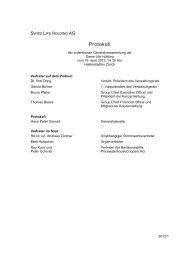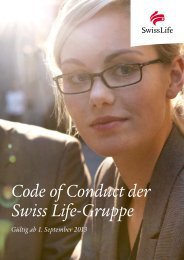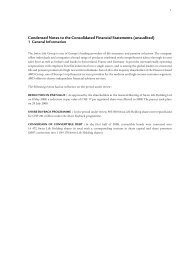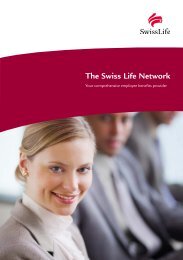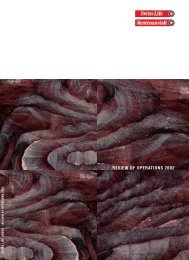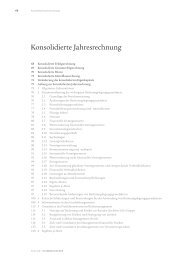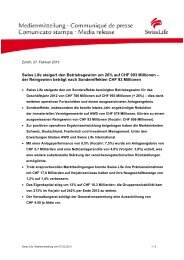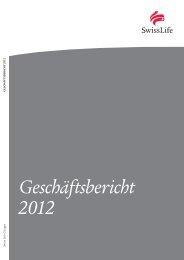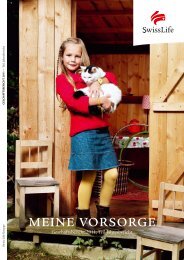Annual Report 2012 - Swiss Life
Annual Report 2012 - Swiss Life
Annual Report 2012 - Swiss Life
Create successful ePaper yourself
Turn your PDF publications into a flip-book with our unique Google optimized e-Paper software.
128 Consolidated Financial Statements<br />
For the purpose of impairment testing, goodwill is allocated to cash-generating units. Goodwill is<br />
tested for impairment annually and whenever there is an indication that the unit may be impaired.<br />
Goodwill is carried at cost less accumulated impairment losses. Impairment losses on goodwill are<br />
not reversed in subsequent periods.<br />
Gains and losses on the disposal of an entity include the carrying amount of goodwill relating to the<br />
entity sold.<br />
Negative goodwill is immediately recognised in profit and loss.<br />
Customer relationships<br />
Customer relationships consist of established relationships with customers through contracts that<br />
have been acquired in a business combination or non-contractual customer relationships that meet<br />
the requirement for separate recognition. They have a definite useful life of generally 5 to 20 years.<br />
Amortisation is calculated using the straight-line method over their useful lives.<br />
Brands and Other<br />
Other intangible assets consist of trademarks, computer software and other.<br />
Brands and trademarks with a definite useful life of generally 5 to 20 years are amortised using the<br />
straight-line method over their useful lives. Brands with an indefinite useful life are tested for impairment<br />
on an annual basis as part of the cash-generating unit to which they belong. They are carried at<br />
cost less accumulated impairment.<br />
Acquired computer software licences are capitalised on the basis of the costs incurred to acquire and<br />
bring to use the specific software. These costs are amortised on a straight-line basis for the expected<br />
useful life up to three years. Costs associated with developing or maintaining computer software<br />
programs are recognised as an expense as incurred. Development costs that are directly associated<br />
with identifiable software products controlled by the Group and that will probably generate future<br />
economic benefits are capitalised. Direct costs include the software development team’s employee<br />
costs. Computer software development costs recognised as assets are amortised using the straightline<br />
method over their useful lives, not exceeding a period of three years.<br />
2.16 Impairment of non-financial assets<br />
For non-financial assets the recoverable amount is mea sured as the higher of the fair value less costs<br />
to sell and its value in use. Fair value less costs to sell is the amount obtainable from the sale of an<br />
asset or cash-generating unit in an arm’s-length transaction between knowledgeable, willing parties,<br />
less the costs of disposal. “Value in use” is the present value of the future cash flows expected to be<br />
derived from an asset or cash-generating unit from its continuing use.<br />
Impairment losses and reversals on other assets are recognised in operating expenses.<br />
2.17 Income taxes<br />
Current and deferred income taxes are recognised in income except when they relate to items recognised<br />
directly in equity. Income taxes are calculated using the tax rates enacted or substantively enacted as<br />
of the balance sheet date.<br />
<strong>Swiss</strong> <strong>Life</strong> – <strong>Annual</strong> <strong>Report</strong> <strong>2012</strong>



